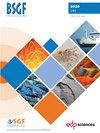突尼斯中部(jebel el kebar地区)中始新世至中新世海洋和大陆沉积物的地层学和沉积学
IF 2.6
3区 地球科学
Q2 GEOSCIENCES, MULTIDISCIPLINARY
引用次数: 9
摘要
突尼斯中部的Kasserine地区,从上白垩纪到中新世中期,长期以来一直被许多作者认为是一个新兴的岛屿(或小岛)。80年代,对始新世的陆相沉积进行了描述和定年。当时,突尼斯中部未发现超过中中新世的海相沉积,唯一的始新世海相地层位于出露带边缘的磷化盆地中。在位于Kasserine地区东部边缘的Djebel el Kebar地区,对始新世-中中新世沉积进行了详细的研究。在研究序列中,观察到四个主要的不整合面,并在整个遗址上进行了对比。在这些表面之间,从底部到顶部观察到三个连续的沉积单元,由灰岩、海绿石和粘土沉积(单元I)、壳层灰岩(单元II)、砾岩、砂岩和粉质粘土沉积(单元III)组成。古生物和生物地层学结果在第一个沉积单元海绿石海相沉积中,在Djebel el Kebar发现了重要的化石位置。动物群非常丰富,包括许多海洋动物(鲨鱼、鳐鱼、海龙等)和大陆动物(啮齿动物、水螅类动物和灵长类动物)。新的测年结果清楚地表明,该系列下部的沉积物年龄为巴顿期。确定了13种沉积相,并利用Djebel el Kebar的特殊露头条件绘制了横向相演化图。重建了沉积环境,其演替为极浅水深的碳酸盐岩台地(以波浪为主,受风暴和潮汐影响),向上进入砂质河流和河口环境。构造-沉积与层序演化提出了一个层序地层格架,在以构造成因为主的不整合面两侧,有3个保存非常完好(> 3 Ma)的层序与2级相匹配[Vail等[1991]][1]。在这些层序中,研究的系列主要分布在海侵体系域和高地体系域。因此,化石位置似乎与二级旋回海侵阶段形成的几个凝结期有关。本工作的第一个重要新成果是对突尼斯中部Djebel el Kebar地区中中新世以上海相沉积物的表征和年代测定。因此,研究区不在始新世时期卡塞林带的出现部分。在巴尔东期和下中新世之间,海相,在极浅海相碳酸台地环境中演化。一个重大事件(中新世的挠曲与上升下降相结合)将导致沉积剖面的改变,粗大的陆源物质的到来,并形成陆相河流和河口沉积环境。最后,整个系列记录了大尺度的构造-隆起变化,由几个二级层序组成,部分保存完好。[1]: # ref - 69本文章由计算机程序翻译,如有差异,请以英文原文为准。
Stratigraphie et sédimentologie des dépôts marins et continentaux d’âge éocène moyen à miocène en Tunisie centrale (région du Djebel el Kébar)
The Kasserine area, in central Tunisia, is for a long time considered by many authors as an emerged island (or islets), since the upper Cretaceous until the middle Miocene. In the eighties, continental deposits were described and dated Eocene. At that time, no marine deposit older than middle Miocene were thus known in central Tunisia, and the only Eocene marine strata, were located in periphery of the emerged zone, in phosphatic basins. It is in the area of Djebel el Kebar, which is situated at the eastern edge of the Kasserine region that a detailed study of the Eocene-middle Miocene deposits was carried out. In the studied series, four major unconformities are observed and correlated on the whole of the site. Between these surfaces, three successive sedimentary units are observed from base to top and are composed of limestone, glauconite and clay deposits (unit I), shell beds limestone (unit II), conglomerate, sandstone and silty-clay (unit III). Paleontological and biostratigraphic results An important fossils locality was discovered in Djebel el Kebar, in glauconitic marine deposits of the first sedimentary unit. Fauna, very rich, contains many marine (shark, ray, sirenian, etc.) and continental forms (rodent, hyracoid and primate). The new dating clearly indicates that the deposits of the lower part of the series are Bartonian in age. Sedimentological results Thirteen facies were identified and the exceptional conditions of outcrop in Djebel el Kebar have allowed us to map the lateral facies evolution. The sedimentary environments were reconstituted and their succession shows a very shallow water-depth carbonate platform (wave dominated and influenced by storms and tide), passing upward into a sandy fluvial and estuarine environment. Tectono-sedimentary and sequential evolution A sequence stratigraphic framework was proposed, in which, on both sides of unconformities primarily of tectonic origin, three very partially preserved sequences (> 3 Ma) are compatible with the second order of [Vail et al. [1991]][1]. In these sequences, the major part of the studied series is set up in transgressive system tracts and highstand system tracts. The fossil locality then seems to be associated with several episodes with condensation, formed during the transgressive part of the second order cycle. Conclusions The first, new and important result of this work, is the characterization and dating of marine deposits older than middle-Miocene in Djebel el Kebar, in central Tunisia. The studied area is thus not in the emerged part of the zone of Kasserine during the Eocene. Between Bartonian and lower-Miocene, marine facies, evolve within an environment of very shallow marine carbonated platform. A major event (flexure coupled with eustatic fall in Miocene) would cause a change of depositional profile, the arrival of coarse terrigenous material and the installation of a continental fluvial and estuarine sedimentary environment. Finally the whole of the series records large scale tectono-eustatic changes, responsible of several second order sequences, partially preserved. [1]: #ref-69
求助全文
通过发布文献求助,成功后即可免费获取论文全文。
去求助
来源期刊
CiteScore
5.80
自引率
0.00%
发文量
18
审稿时长
>12 weeks
期刊介绍:
BSGF - Earth Sciences Bulletin publie plusieurs types de contributions :
1. des articles originaux, couvrant tous les champs disciplinaires des Géosciences, à vocation fondamentale mais également à vocation plus appliquée (risques, ressources);
2. des articles de synthèse, faisant le point sur les avancées dans un domaine spécifique des Géosciences, qu''elles soient méthodologiques ou régionales ;
3. des monographies sur la géologie d’une région donnée, assorties d’informations supplémentaires, cartes, coupes, logs, profils sismiques … publiées en ligne en annexe de l’article ;
4. des articles courts de type « express letter » ;
5. des livrets-guides d’excursion (qui suivront le même processus d’examen éditorial que les articles plus classiques) ;
6. des comptes rendus de campagnes à la mer ;
7. des articles de données géodésiques, géophysiques ou géochimiques, pouvant devenir des articles de référence pouvant conduire à des interprétations ultérieures.
BSGF - Earth Sciences Bulletin constitue également un forum pour les discussions entre spécialistes des Sciences de la Terre, de type comment-reply ou autre. Tous les articles publiés, quelle que soit leur forme, seront accessibles sans frais (articles en Open Access) sur le site de la SGF et sur celui de Geosciences World dans la mesure où les auteurs se seront acquittés d’une contribution de (Article Processing Charges – APC) de 300€ pour les membres de la SGF et 500€ pour les non-membres.

 求助内容:
求助内容: 应助结果提醒方式:
应助结果提醒方式:


